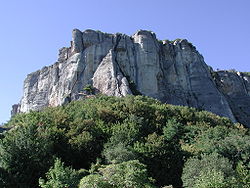
Calcarenite is a type of limestone that is composed predominantly, more than 50 percent, of detrital (transported) sand-size (0.0625 to 2 mm in diameter), carbonate grains. The grains consist of sand-size grains of either corals, shells, ooids, intraclasts, pellets, fragments of older limestones and dolomites, other carbonate grains, or some combination of these. Calcarenite is the carbonate equivalent of a sandstone. The term calcarenite was originally proposed in 1903 by Grabau[1][2] as a part of his calcilutite, calcarenite and calcirudite carbonate classification system based upon the size of the detrital grains composing a limestone.[3][4] Calcarenites can accumulate in a wide variety of marine and non-marine environments. They can consist of grains of carbonate that have accumulated either as coastal sand dunes (eolianites), beaches, offshore bars and shoals, turbidites, or other depositional settings.[3][5]
- ^ Grabau, A.W. (1903) Paleozoic coral reefs. Geological Society of America Bulletin. vol. 14, pp. 337-352.
- ^ Grabau, A.W. (1904) On the classification of sedimentary rocks. American Geologist. vol. 33, pp. 228-247.
- ^ a b Flügel, E. (2010) Microfacies of Carbonate Rocks, 2nd ed. Springer-Verlag Berlin, Germany. 976 pp. ISBN 978-3-540-22016-9
- ^ Neuendorf, K.K.E., J.P. Mehl, Jr., and J.A. Jackson, J.A., eds. (2005) Glossary of Geology (5th ed.). Alexandria, Virginia, American Geological Institute. 779 pp. ISBN 0-922152-76-4
- ^ Scholle, P.A., D.G. Bebout, and C.H. Moore (1983) Carbonate Depositional Environments. Memoir no. 33. Tulsa, Oklahoma, American Association of Petroleum Geologists. 708 pp. ISBN 978-0-89181-310-1